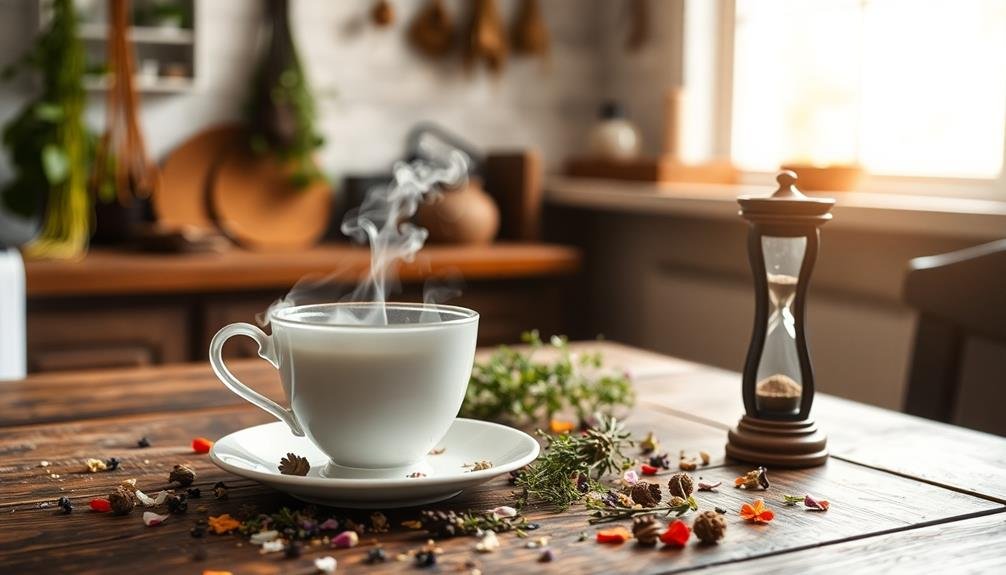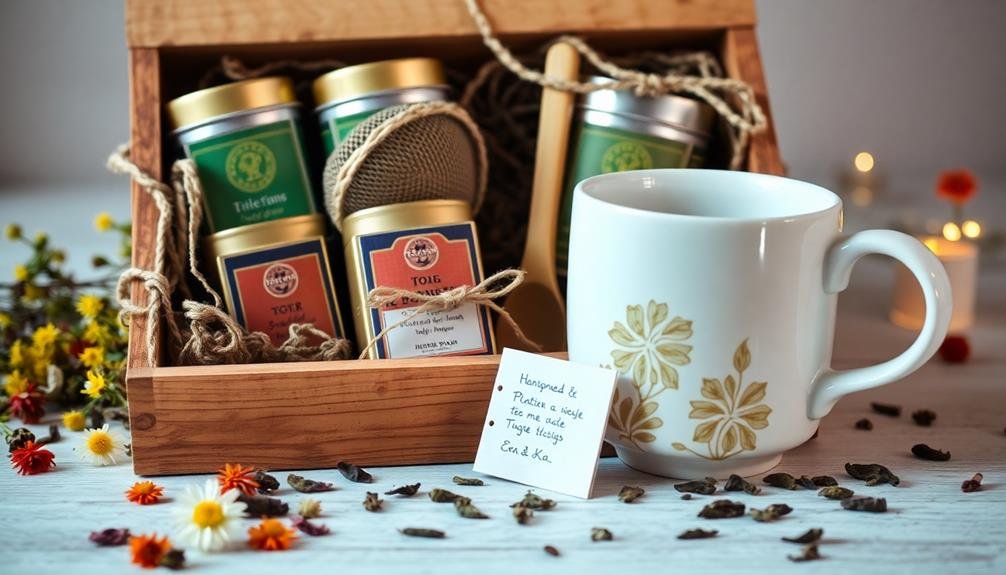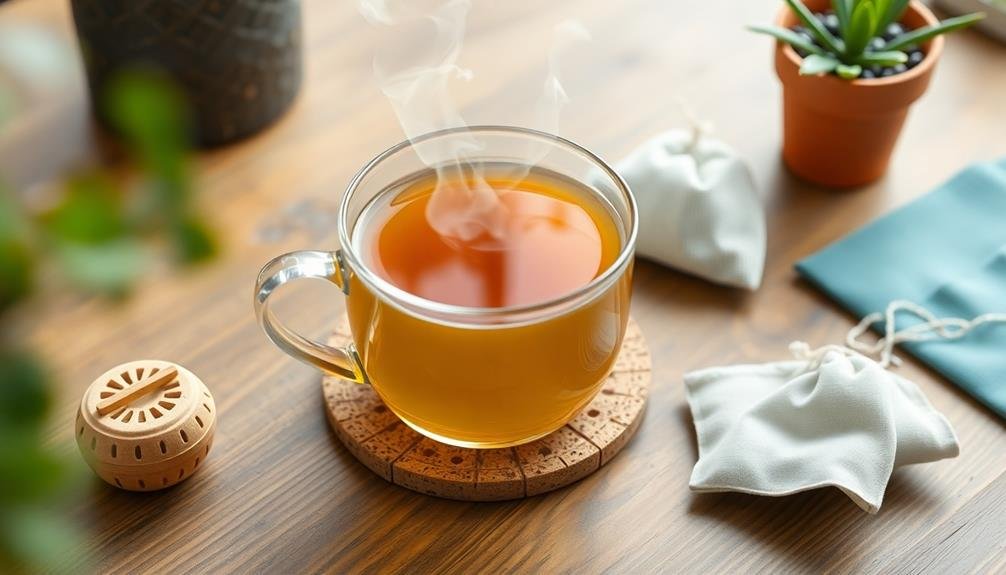For ideal flavor and benefits, steep chamomile and peppermint for 5-7 minutes, ginger for 5-10 minutes, and lavender for 5-7 minutes. Hibiscus needs 5-7 minutes, while lemon balm requires 5-7 minutes. Echinacea steeps best for 10-15 minutes, rooibos for 5-7 minutes, and dandelion root for 10-15 minutes. Nettle leaf takes 5-10 minutes to extract its full capability. Remember to use hot water just below boiling point for most teas, and cover your cup while steeping to retain heat and aromatic compounds. By mastering these steeping times, you'll reveal a world of herbal tea enjoyment and wellness.
Chamomile: Gentle Sleep Aid

For a soothing cup of chamomile tea, steep the flowers for 5 to 7 minutes. This gentle herb is renowned for its calming properties and can help you unwind before bedtime. Use one teaspoon of dried chamomile flowers per cup of hot water, or a tea bag if you prefer convenience.
While steeping, cover your cup to retain the essential oils and maximize the tea's therapeutic benefits. The longer you steep, the stronger the flavor will be, but avoid exceeding 10 minutes to prevent bitterness. If you're sensitive to caffeine, chamomile is an excellent choice as it's naturally caffeine-free.
To enhance your chamomile tea experience, try adding a slice of lemon or a teaspoon of honey. These additions can complement the tea's delicate, apple-like flavor and boost its health benefits.
For a more potent sleep aid, combine chamomile with other relaxing herbs like lavender or valerian root.
Peppermint: Cooling Digestive Soother
A zesty burst of coolness awaits you with peppermint tea. This invigorating brew offers more than just a revitalizing taste; it's a natural remedy for various digestive issues. When you're feeling bloated or experiencing indigestion, reach for a cup of peppermint tea to soothe your stomach.
To achieve the ideal cup, steep your peppermint tea for 5-7 minutes in water that's just below boiling point (around 200°F or 93°C). This allows the leaves to release their essential oils and medicinal properties without becoming bitter. Here's a quick guide to help you get the most out of your peppermint tea:
| Steeping Time | Water Temperature | Benefits |
|---|---|---|
| 3-5 minutes | 200°F / 93°C | Mild flavor |
| 5-7 minutes | 200°F / 93°C | Optimal flavor |
| 7-10 minutes | 200°F / 93°C | Stronger, medicinal |
Ginger: Spicy Immune Booster

While peppermint offers a cooling sensation, ginger tea brings a spicy kick that's perfect for warming you up and boosting your immune system. This zesty root has been used for centuries to aid digestion, reduce inflammation, and fight off colds and flu.
To get the most out of your ginger tea, you'll want to steep it properly. For the best results, use fresh ginger root sliced into thin pieces. If you're using dried ginger, opt for a high-quality, organic version.
Here's how to steep your ginger tea:
- Boil water and let it cool for about 30 seconds
- Add 1-2 teaspoons of ginger per cup of water
- Steep for 5-10 minutes, depending on desired strength
- Strain and enjoy, adding honey or lemon if desired
The longer you steep, the stronger and spicier your tea will be. If you find the flavor too intense, you can dilute it with more hot water.
Lavender: Calming Floral Infusion
You'll find lavender tea to be a soothing herbal infusion with numerous calming benefits.
For the best results, steep your lavender tea for 5-7 minutes in water just below boiling point.
As you sip, you'll notice a distinct floral aroma and a slightly sweet, herbaceous flavor that can help promote relaxation and better sleep.
Lavender's Soothing Health Benefits
Lavender tea stands out as a popular choice for those seeking relaxation and stress relief. When you sip on this aromatic brew, you're not just enjoying a delightful flavor; you're also reaping numerous health benefits. Lavender's soothing properties can help calm your nerves, reduce anxiety, and promote better sleep quality.
Research suggests that lavender tea may offer additional health advantages, including:
- Improved digestion and reduced bloating
- Enhanced skin health due to its antioxidant properties
- Potential pain relief for headaches and menstrual cramps
- Boosted immune system function
When you're feeling stressed or overwhelmed, brewing a cup of lavender tea can be an effective natural remedy.
It's crucial to recognize that while lavender tea is generally safe for most people, you should consult your healthcare provider if you're pregnant, nursing, or taking medications.
To maximize the benefits of lavender tea, steep it for 5-7 minutes in hot water, allowing the flavors and beneficial compounds to fully infuse. You can also combine lavender with other herbs like chamomile or lemon balm for a more complex flavor profile and additional health benefits.
Optimal Steeping Time
How long should you steep lavender tea to achieve the perfect balance of flavor and therapeutic benefits? The ideal steeping time for lavender tea is typically between 5 to 7 minutes. This duration allows enough time for the hot water to extract the essential oils and beneficial compounds from the lavender buds without making the tea too bitter or overwhelming.
To prepare your lavender tea, start with fresh or dried lavender flowers. Use about 1 teaspoon of dried lavender or 1 tablespoon of fresh lavender per cup of water. Boil the water and let it cool for a minute before pouring it over the lavender.
Cover the cup or teapot to prevent the volatile oils from escaping. After 5 minutes, taste the tea. If you prefer a stronger flavor or want to maximize the calming effects, let it steep for up to 7 minutes.
Be cautious not to over-steep, as this can lead to a bitter taste and potentially reduce some of the tea's benefits. Once you've reached your desired strength, strain the lavender and enjoy your soothing cup of tea.
Flavor Profile Exploration
With its distinctive aroma and soothing properties, lavender tea offers a unique flavor profile that's both calming and revitalizing. As you explore this floral infusion, you'll notice its subtle complexity and delicate taste. The key to revealing lavender tea's full potential lies in proper steeping techniques and understanding its flavor nuances.
To fully appreciate lavender tea's flavor profile, consider these aspects:
- Aroma: Inhale deeply before sipping to experience the tea's fragrant bouquet.
- Initial taste: Notice the light, floral notes that dance on your tongue.
- Mid-palate: Identify any herbal or slightly sweet undertones.
- Aftertaste: Observe the lingering, soothing sensation.
You'll find that lavender tea's flavor can vary depending on factors such as water temperature and steeping time. Experiment with these variables to discover your preferred balance.
For a milder taste, steep for 3-4 minutes using water just below boiling. If you prefer a stronger infusion, try a 5-7 minute steep.
Don't be afraid to blend lavender with other herbs or add a touch of honey to enhance its natural sweetness. By exploring these options, you'll develop a deeper appreciation for this calming herbal tea.
Hibiscus: Tangy Vitamin C Source

You'll love the vibrant, tangy flavor of hibiscus tea, which packs a punch of vitamin C. This ruby-red herbal infusion offers a revitalizing taste that's both tart and slightly sweet.
To steep the perfect cup, use about 1-2 teaspoons of dried hibiscus flowers per cup of water. Bring water to a boil, then pour it over the flowers and let it steep for 5-7 minutes.
For a stronger brew, you can increase the steeping time up to 10 minutes, but be aware that this may result in a more intense, acidic flavor. If you find the taste too tart, try adding a touch of honey or stevia to balance it out.
Hibiscus tea can be enjoyed hot or cold, making it a versatile option for any season.
Remember that hibiscus can interact with certain medications, particularly those for high blood pressure. It's also known to have mild diuretic properties.
If you're pregnant or have any health concerns, it's best to consult with your healthcare provider before incorporating hibiscus tea into your regular routine.
Lemon Balm: Mood-Lifting Citrus Brew
Lemon balm, a member of the mint family, offers a delightful citrusy aroma and a gentle, calming effect. This herb has been used for centuries to promote relaxation and improve mood.
When brewing lemon balm tea, you'll want to steep it for 5-7 minutes to extract its full flavor and beneficial properties.
To make the perfect cup of lemon balm tea, follow these steps:
- Boil fresh, filtered water
- Place 1-2 teaspoons of dried lemon balm leaves in a tea infuser
- Pour hot water over the leaves and cover
- Let steep for 5-7 minutes, then remove the infuser
You can enjoy lemon balm tea hot or iced, and it pairs well with honey or a slice of lemon.
This herb is known for its mood-lifting properties and may help reduce stress and anxiety. It's also been linked to improved cognitive function and better sleep quality.
If you're looking for a caffeine-free alternative to your usual tea, lemon balm is an excellent choice. Its light, invigorating taste makes it perfect for any time of day, whether you need a morning pick-me-up or an evening wind-down.
Echinacea: Cold-Fighting Herbal Remedy

Brewed from the vibrant purple coneflower, echinacea tea packs a powerful punch against the common cold. This herbal remedy has been used for centuries to boost the immune system and fight off infections.
To reap its full benefits, you'll want to steep echinacea tea properly. For the best results, use 1-2 teaspoons of dried echinacea root, leaves, or flowers per cup of boiling water. Let it steep for 10-15 minutes to extract the herb's medicinal properties. If you're using echinacea tea bags, steep for 5-10 minutes. The longer steeping time allows the water to fully absorb the herb's active compounds.
You can drink echinacea tea up to three times a day when you're feeling under the weather. It's most effective when consumed at the first sign of illness.
The tea has a slightly sweet, floral taste with earthy undertones. If you find it too bitter, add a touch of honey or lemon to improve the flavor.
Rooibos: Antioxidant-Rich Red Tea
Rooibos, also known as red bush tea, hails from South Africa and boasts a rich array of antioxidants. This caffeine-free herbal tea offers a smooth, slightly sweet flavor that's perfect for any time of day. To reveal its full potential, you'll want to steep rooibos properly.
For the best results, use water that's just off the boil, around 200°F (93°C). Add one teaspoon of loose rooibos or one tea bag per cup of water. Steep for 5-7 minutes, depending on your desired strength. Unlike true teas, rooibos won't become bitter with extended steeping, so feel free to experiment.
Rooibos tea offers several health benefits:
- High in antioxidants, which may help fight inflammation
- Supports heart health by potentially lowering blood pressure
- May improve bone health due to its mineral content
- Can be enjoyed hot or iced, making it versatile for any season
You can enhance your rooibos experience by adding a slice of lemon, a dash of honey, or a splash of milk.
For a revitalizing summer drink, try cold brewing rooibos overnight in the refrigerator. Remember, the key to a perfect cup lies in quality tea and proper steeping techniques.
Dandelion Root: Liver-Cleansing Tonic

Often overlooked as a pesky weed, dandelion root has been used for centuries as a powerful herbal remedy. This liver-cleansing tonic offers numerous health benefits, including improved digestion and reduced inflammation. To harness its full potential, you'll need to steep it properly.
For dandelion root tea, aim for a steeping time of 10 to 15 minutes. Use about 1 to 2 teaspoons of dried root per cup of boiling water. The longer you steep, the stronger and more bitter the flavor becomes. If you're new to dandelion root tea, start with a shorter steeping time and gradually increase it to suit your taste preferences.
To enhance the flavor, you can add a slice of lemon or a touch of honey. Some people also combine dandelion root with other herbs like ginger or cinnamon for a more complex taste profile. Remember to strain the tea before drinking to remove any root particles.
When consuming dandelion root tea, start with one cup per day and monitor how your body responds. As with any herbal remedy, it's wise to consult your healthcare provider, especially if you have existing medical conditions or are taking medications.
Nettle Leaf: Nutrient-Packed Green Infusion
Nettle leaf tea offers a wealth of nutrients and potential health benefits, including support for urinary health and reducing inflammation.
You'll want to steep nettle leaf for 5-10 minutes in hot water to extract its beneficial compounds fully.
The resulting infusion has a mild, earthy flavor with a slightly sweet aftertaste, reminiscent of other green teas but with its own unique character.
Health Benefits Overview
With a reputation for being a nutrient powerhouse, nettle leaf tea offers an impressive array of health benefits. When you sip on this vibrant green infusion, you're treating your body to a blend of vitamins, minerals, and antioxidants that can support your overall well-being.
Nettle leaf tea is known for its ability to:
- Boost your immune system with its high vitamin C content
- Support healthy bones and teeth thanks to its calcium and magnesium
- Aid in digestion and reduce inflammation in the gut
- Promote healthy skin and hair growth due to its silica content
You'll also find that nettle leaf tea can help manage allergies, reduce joint pain, and support urinary tract health.
Its natural diuretic properties may assist in flushing out toxins and reducing water retention. Additionally, this herbal infusion can potentially lower blood pressure and blood sugar levels, making it a significant addition to your daily routine.
Optimal Steeping Time
To extract the full spectrum of nutrients from nettle leaf tea, proper steeping time is crucial. You'll want to aim for 10-15 minutes to guarantee you're getting the most out of this nutrient-packed green infusion. Nettle leaf is known for its high mineral content, including iron, calcium, and magnesium, as well as vitamins A and C.
During the steeping process, the hot water slowly releases these beneficial compounds into your cup. If you steep for too short a time, you won't get the full nutritional benefits. On the other hand, steeping too long can lead to a bitter taste. Here's a quick guide to help you achieve the perfect cup:
| Water Temperature | Steeping Time | Taste Profile |
|---|---|---|
| 200°F (93°C) | 5 minutes | Mild, grassy |
| 200°F (93°C) | 10 minutes | Balanced |
| 200°F (93°C) | 15 minutes | Strong, earthy |
| 200°F (93°C) | 20 minutes | Intense, bitter |
| Cold brew (4°C) | 8-12 hours | Smooth, subtle |
Flavor and Aroma
Now that you've mastered the ideal steeping time, let's explore the unique flavor profile of nettle leaf tea. This nutrient-packed green infusion offers a distinctive taste that's often described as earthy and herbaceous.
When properly steeped, nettle leaf tea delivers a robust flavor with subtle grassy notes and a slightly sweet aftertaste.
The aroma of nettle leaf tea is equally enchanting, reminiscent of fresh hay and green vegetables. As you inhale the steam rising from your cup, you'll notice a crisp, clean scent that invigorates the senses.
To fully appreciate the flavor and aroma of nettle leaf tea, consider these elements:
- Temperature: Steep at 200°F (93°C) for ideal flavor extraction
- Steeping time: Aim for 5-7 minutes to balance strength and bitterness
- Water quality: Use filtered water to avoid interfering with the tea's natural taste
- Serving: Enjoy plain or with a touch of honey to enhance its natural sweetness
Frequently Asked Questions
Can I Reuse Herbal Tea Bags for a Second Cup?
You can reuse herbal tea bags, but the second cup won't be as flavorful. It's safe to steep them again, though you'll get a weaker brew. For the best taste, use a fresh tea bag each time.
How Long Can I Store Brewed Herbal Tea in the Refrigerator?
You can store brewed herbal tea in the refrigerator for up to 3-4 days. Make sure it's in an airtight container to maintain freshness. It's best to consume it within 48 hours for ideal flavor and quality.
Are There Any Herbal Teas I Should Avoid During Pregnancy?
You should avoid certain herbal teas during pregnancy. Don't drink chamomile, licorice root, or pennyroyal tea. They may cause complications. Stick to safe options like ginger or peppermint, but always consult your doctor before consuming any herbal tea.
Can I Mix Different Herbal Teas Together for Unique Flavors?
Yes, you can mix different herbal teas for unique flavors. It's a fun way to create custom blends. Experiment with combinations you enjoy, but be mindful of potential interactions. Start with small amounts to test flavors and effects.
What's the Best Way to Sweeten Herbal Teas Without Using Sugar?
You've got several great options to sweeten your herbal tea without sugar. Try natural alternatives like honey, stevia, or agave nectar. You can also use fruit juices, cinnamon sticks, or vanilla extract for added flavor and sweetness.
In Summary
You've now got the perfect steeping times for your favorite herbal teas. Remember, these are guidelines, so feel free to adjust to your taste. Don't be afraid to experiment with blending different herbs for unique flavors and benefits. Whether you're seeking relaxation, digestive support, or an immune boost, there's a tea for every need. Embrace the ritual of brewing and sipping these natural infusions, and you'll soon discover the perfect cup for any moment.





Leave a Reply